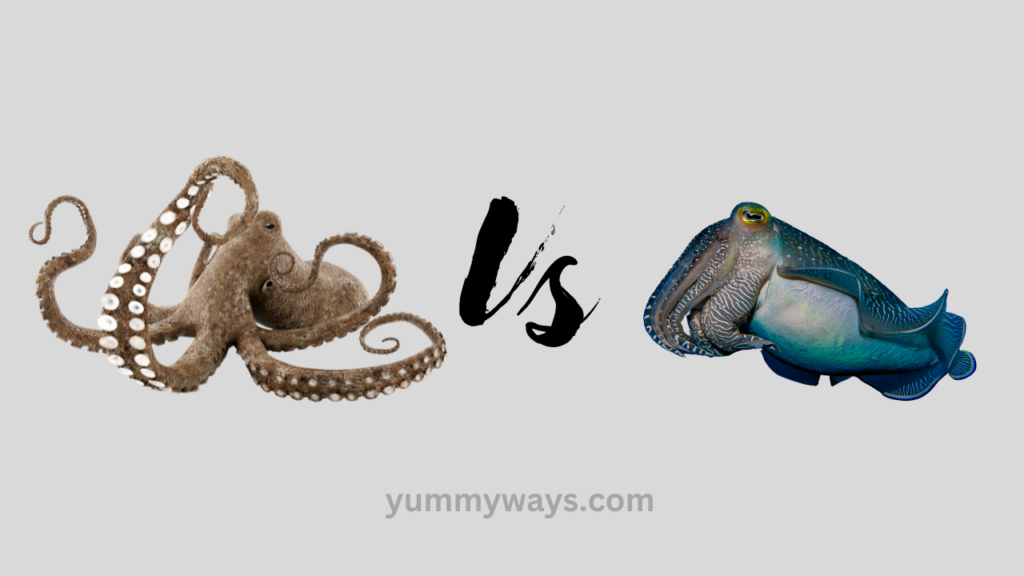Cuttlefish and octopuses belong to the same family, sharing numerous similarities. However, distinguishing between them becomes simple when you know the key features. Explore the distinctions and commonalities between cuttlefish and octopuses in the following discussion!
In the vast depths of the ocean, there lies a fascinating world filled with mesmerizing creatures. Two of the most intriguing cephalopods found in these depths are the octopus and the cuttlefish. While they appear similar at first glance, numerous differences set them apart. In this article, we will explore the unique characteristics of both the octopus and the cuttlefish, highlighting their physical attributes, behaviours, and habitats. Join us on this underwater adventure as we delve into the world of octopuses and cuttlefish.

Also Read: Salmon vs Tuna Nutrition: Unlock the Power of Oceanic Superfoods
Contents
What is Octopus?
The octopus, a cephalopod mollusc, boasts a distinctive physique with a bulbous head and eight flexible arms adorned with suckers. Classified under Cephalopoda, meaning “head foot” in Greek, these intelligent marine creatures captivate with their problem-solving abilities and complex behaviours, contributing to the intrigue surrounding these remarkable denizens of the ocean.
What is Cuttlefish?
Cuttlefish is a marine animal belonging to the same class as octopuses and squids, known as Cephalopoda. These creatures have a unique internal shell called a cuttlebone, which helps with buoyancy. Cuttlefish are highly intelligent and possess the ability to change colour and texture for communication, camouflage, and hunting.
Overview Of Octopus vs Cuttlefish
| Feature | Octopus | Cuttlefish |
|---|---|---|
| Class | Cephalopoda | Cephalopoda |
| Body Structure | Bulbous head, eight flexible arms | Bulbous body, eight arms with suckers |
| Shell | No external shell; some have a beak | Internal shell (cuttlebone) for buoyancy |
| Intelligence | Highly intelligent | Highly intelligent |
| Defence Mechanism | Ink expulsion for camouflage and escape | Ink expulsion for camouflage and escape |
| Colour Change | Ability to change colour and texture | Ability to change colour and texture |
| Communication | Complex signalling through body patterns | Communication through body patterns |
| Habitat | Marine environments | Marine environments |
| Lifespan | Short-lived, 1-2 years | Varies by species, generally 1-3 years |
| Reproduction | Semelparous (single reproduction event) | Semelparous (single reproduction event) |
Similarities: Octopus vs Cuttlefish
Octopuses and cuttlefish share several similarities due to their common classification within the cephalopod family. Here are some commonalities between octopuses and cuttlefish:
- Cephalopoda Classification: Both octopuses and cuttlefish belong to the class Cephalopoda, which also includes squids and nautiluses.
- Intelligence: Octopuses and cuttlefish are both highly intelligent marine animals, exhibiting advanced problem-solving skills and complex behaviors.
- Body Structure: Both have a soft body, a bulbous head, and multiple arms. Octopuses have eight flexible arms, while cuttlefish have eight arms with suckers.
- Camouflage: Both species are adept at changing their colour and texture, enabling them to camouflage effectively for hunting, communication, and defence.
- Ink Expulsion: Both octopuses and cuttlefish use ink expulsion as a defence mechanism. They release a cloud of ink to create a diversion and escape from predators.
- Marine Habitat: Octopuses and cuttlefish inhabit marine environments, ranging from shallow coastal waters to deeper ocean regions.
- Communication: Both species communicate through complex body patterns, using their ability to change colour and texture for signalling to conspecifics or for courtship displays.
- Short Lifespan: both octopuses and cuttlefish have relatively short lifespans, with variations depending on the species.
Are cuttlefish smarter than octopus?
Both cuttlefish and octopuses are considered highly intelligent marine animals, and it’s challenging to definitively state that one is universally smarter than the other. Their intelligence is often evaluated based on different criteria, and the assessments might vary across species.
Octopuses are known for their exceptional problem-solving abilities and complex behaviours. They are capable of learning through observation, manipulating objects, and escaping from predators or confined spaces. Their ability to use tools and exhibit curiosity is well-documented.
Cuttlefish also exhibit remarkable intelligence. They are known for their advanced camouflage techniques, communication through body patterns, and the ability to solve problems. Cuttlefish are quick learners and show adaptability in various situations.
Comparing their intelligence is challenging because it depends on the specific cognitive tasks being assessed and the criteria used for evaluation. Both cuttlefish and octopuses have demonstrated cognitive abilities that make them fascinating subjects for scientific study.
Also Read: Sockeye vs Atlantic Salmon: Which One Reigns Supreme in Taste and Flavor
What are the major differences between the nautilus cuttlefish squid and octopus?
The nautilus, cuttlefish, squid, and octopus are all members of the cephalopod class, but they exhibit several differences in terms of anatomy, behaviour, and habitat. Here are some major distinctions:
- Shell Presence:
- Nautilus: Nautiluses have an external spiral shell that provides buoyancy.
- Cuttlefish: Cuttlefish have an internal shell called a cuttlebone, used for buoyancy.
- Squid: Squids have a small internal, pen-shaped shell.
- Octopus: Octopuses do not have a shell; their body is soft and flexible.
- Body Shape:
- Nautilus: has a coiled, external shell and tentacles with a tube-like body.
- Cuttlefish: Possesses a broad, flattened body with a cuttlebone and short tentacles.
- Squid: Has a streamlined body with a distinct head, mantle, and long tentacles.
- Octopus: Features a bulbous head and a soft, flexible body with eight arms.
- Tentacles/Arms:
- Nautilus: has around 90 tentacles.
- Cuttlefish: has eight arms and two longer tentacles.
- Squid: Has eight arms and two longer tentacles.
- Octopus: Possesses eight arms.
- Mobility:
- Nautilus: Moves using jet propulsion by expelling water from its mantle cavity.
- Cuttlefish: Moves using jet propulsion and can also hover using its cuttlebone.
- Squid: Uses jet propulsion for rapid movement.
- Octopus: Moves by crawling and jet propulsion.
- Camouflage:
- Nautilus: Limited camouflage ability compared to other cephalopods.
- Cuttlefish: Masters of camouflage, capable of changing colour and texture rapidly.
- Squid: Can change colour for camouflage but not as adept as cuttlefish.
- Octopus: Excellent at changing colour and texture for camouflage.
- Habitat:
- Nautilus: Primarily found in deep, open ocean waters.
- Cuttlefish: Inhabit shallow coastal waters and deeper ocean areas.
- Squid: Found in various marine environments, from shallow to deep waters.
- Octopus: Occupy diverse habitats, including coral reefs, deep-sea floors, and rocky shores.
- Lifespan:
- Nautilus: longer-lived, with some species living several decades.
- Cuttlefish: have shorter lifespans, around 1-3 years.
- Squid: Lifespan varies but is generally shorter than that of nautiluses.
- Octopus: Lifespan varies by species but is generally short, often 1-2 years.
Conclusion
While octopuses and cuttlefishes share a common ancestry and belong to the same class of cephalopods, they have distinct characteristics that make them unique. The octopus, with its flexible tentacles and remarkable intelligence, navigates the depths with cunning and precision. The cuttlefish, with its elongated body and mesmerizing displays, captivates us with its beauty and adaptability. Both creatures are marvels of the underwater world, showcasing the wonders of evolution and the diversity of life in our oceans. Let us continue to explore and appreciate these incredible creatures, ensuring their conservation and preservation for future generations.
FAQ
What is the difference between an octopus and a cuttlefish?
An octopus and a cuttlefish are both cephalopods, but there are some key differences. Octopuses have a rounded body, eight arms, and lack an internal shell, while cuttlefish have a more elongated body, eight arms and two tentacles, and possess an internal shell called a cuttlebone.
How do octopuses and cuttlefish use their camouflage abilities?
Octopuses and cuttlefish have specialized skin cells called chromatophores that allow them to change colours and patterns to match their surroundings. They use this ability for camouflage and communication, helping them blend in or send visual signals to other animals.
Can octopuses and cuttlefish regenerate their limbs?
No, octopuses and cuttlefish cannot regenerate their limbs like some other animals. If they lose an arm or tentacle, it doesn’t grow back. However, they can heal wounds and may compensate for lost limbs through their exceptional problem-solving skills.
Are octopuses and cuttlefish venomous?
Yes, both octopuses and cuttlefish have venomous capabilities. They possess venom glands that produce toxins, which they mainly use for hunting prey and defending themselves against predators. However, the venom of most species is not harmful to humans.
Can octopuses and cuttlefish swim?
Yes, octopuses and cuttlefish are capable swimmers. They use jet propulsion by expelling water from their body cavity through a siphon, allowing them to move backwards or forward. They can also change direction rapidly by adjusting the direction of the siphon.
What do octopuses and cuttlefish eat?
Octopuses and cuttlefish are carnivorous and feed on a variety of marine creatures. They consume small fish, crustaceans, molluscs, and even other cephalopods. They are opportunistic predators and use their excellent hunting skills to capture their prey.
How long do octopuses and cuttlefish live?
The lifespan of octopuses and cuttlefish varies between species. On average, most octopuses live for 1-2 years, while cuttlefish can live for 1-3 years. However, there are exceptions, with some species of octopuses living up to 5 years and some cuttlefish reaching 4 years.
Do octopuses and cuttlefish have any predators?
Octopuses and cuttlefish have several predators in their natural habitats, including larger fish, sharks, seabirds, and marine mammals. They have developed various defence mechanisms, such as camouflage, ink release, and jet propulsion, to evade or confuse their predators.
Can octopuses and cuttlefish communicate with each other?
Octopuses and cuttlefish have complex communication systems. They use changes in colour and patterns, body postures, and specialized displays to communicate with each other. These visual signals play a crucial role in mating, territorial disputes, and other social interactions.
Are octopuses and cuttlefish intelligent?
Yes, octopuses and cuttlefish are considered highly intelligent marine animals. They have exceptional problem-solving abilities, can learn from experience, and display complex behaviours. Their advanced cognitive abilities have fascinated scientists and continue to be an area of study.

